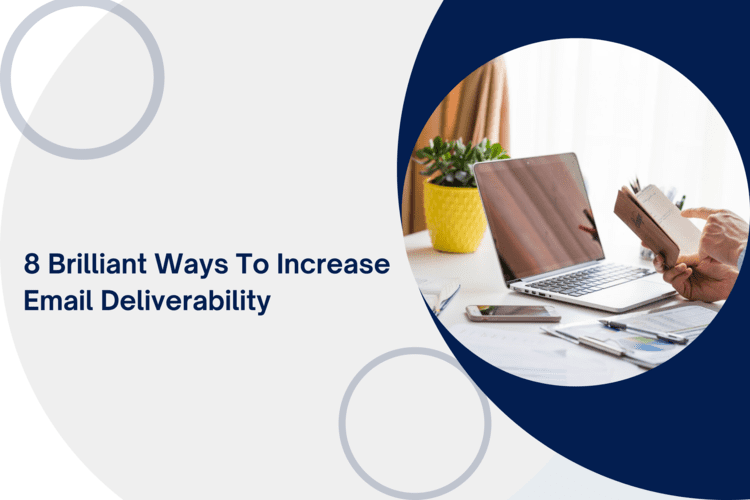
8 Brilliant ways to Increase Email Deliverability
Getting emails delivered to the user’s inbox is one of the biggest difficulties most email marketers struggle with. It’s discouraging to see your emails land in spam despite all the effort and time you’re invested in creating a compelling email.
Your emails are pointless unless they actually make it to the user’s inbox.If your emails aren’t getting delivered, then email marketing is a massive waste of time,money and efforts Email marketing is not just about subject lines, open rates, engaging content, powerful CTAs, and strategic email landing pages. But let’s take a step back and look at the picture from its foundational level – email deliverability.
Difference Between Email Delivery and Email Deliverability
Before we go ahead with the ways, we want to shed light on how email delivery and email deliverability are two different metrics.
1. Email Delivery
Email delivery computes whether or not the recipient can accept your emails. If an email is not bounced, it’s been received by the recipient. Therefore, you’ll see a good email delivery rate. Email delivery rate doesn’t distinguish between email getting delivered to the inbox or spam or junk folder. It just measures the number of emails that didn’t get bounced without considering where actually it has been delivered.
2. Email Deliverability
After the recipient’s server agrees to receive the email, the next challenge is making it to the user’s inbox and not the spam/junk folder. This is where the email deliverability or inbox placement rate comes in. It measures the number of emails actually delivered to the recipient’s inbox.
Let’s dive right into the 12 of the smartest and most effective tactics to increase your deliverability rate.
3. Authenticate Your Domain
The vital component of setting up the right email infrastructure is to authenticate your sender domain.Email authentication channels to your recipient’s server that the email is from a verified and legitimate domain, not a fraudster. Therefore, email authentication is compulsory, so your email doesn’t end up in a spam folder.
4. Warmup Ip For Success
The job of Internet Service providers filters is to protect from spam emails.It is important to tell these filters that your IP is valid and trustworthy.Before you send emails from an IP address, it’s essential to do an IP warmup. You should reach out to your Email Service Provider (ESP) as they’ll help you set up the whole warmup program.You can do this by starting any email campaign by delivering small batches of emails. As these emails are received and opened by already engaged users, your IP will start to build trust and lead to a good score, in a manner of speaking, with the ISP. Gradually, increase the number of emails until you scale to your peak volume.As your score build up, within a week or two, you’ll be able to send a large number of emails without any deliverability issue
5. Have An Close Eye On Your Sender Reputation
The reason why your emails are not delivered is due to a low sender score. ISPs automatically reject emails that fall below a certain score. Sender Score allots a number to every outgoing mail server. The score is computed by using traditional email metrics such as unsubscribes and spam reports.The sender score is on a scale from 0-100, the higher the better.It’s important that you keep a close eye on your score. It is essential to have a good sender reputation, and you can measure it by factors like complaints filed against you by the user, your company’s email history to date, your company domain’s reputation, and the bounce rate. There are tools that will help you generate sender scores and give insights to improve it.
6. Check Feedback Loops Regularly And Fix Issues
Most of the major ISPs provide feedback loops in which the email sender can gain information from the recipients who have complained about that sender’s email. These are called Complaint Feedback Loops or FBLs. Only ESPs (email service providers) are allowed to enter into Gmail’s FBL program.Tools like Google postmaster will help you deal with the challenge.
7. Stick To A Consistent Send Schedule
One reason for a lower sender score and IP rejection is random broadcast activity. If you are not maintaining a regular schedule with your emails, it creates a skewer impression. Do your best to stick to a consistent schedule for sending your email with the right frequency and timing so that people don’t ignore your email.There is no point in sending emails when people cannot view them, so choosing the right time and day is essential based on industry, email campaign type, and your receipt’s interaction behaviors.Besides the timing, maintaining a consistent frequency also helps improve deliverability as it eliminates the chances of spikes that might occur if you send many emails together.
8. Use A Double Opt-In Or Confirmed Opt-In
The most popular form of opt-in is the single opt-in, in which the user agrees to receive an email by simply checking a box. But, it can backfire by generating high amounts of spam complaints. Spam complaints are dangerous for the sender’s score.ISPs begin to block sending servers after as few spam reports.The best solution to defend against spam complaints is to use a double opt-in. All you do is send a confirmation email to the new subscriber and gain their consent. Ensure that all the subscribers on your email list are genuinely interested in receiving your emails.One way to ensure that is to use double opt-in.Asking users to verify their email address after they signup is an easy and quick way to check the validity of their email address. It also prevents sending emails to users who are interested in your product, increasing email engagement.
9. Purge Your List
Stop sending your marketing emails to non-existent users,that will only ramp up your bounce rate and destroy your send credibility. Every now and then, filter out all users who have not opened or clicked your emails in a few months.You may use a paid service to clean all hard bounces before you launch a fresh email marketing effort.Its just about cutting the dead weight from your list.Some subscribers will stop engaging with your emails or change their email address due to a change in job profile or any other external reason. If you still keep sending them emails, you might not get any engagement due to such reasons.
10. Send Emails At Just The Right Frequency
Do not burn out your list by sending too many emails. However, too few emails can kill your revenue.Sending the right amount of emails is a key to maximize deliverability and the way to find the perfect amount is thoroughly testing.A good target is one email per week. You can try scaling up to twice weekly You can even drop back to once a month without completely losing touch with your audience. But it is important to maintain that range.
Conclusion:
In order for email marketing to be effective, the email deliverability rate should be higher. It drives engagement and increase in revenue. Ultimate goal is to create a superior email marketing funnel. Email marketing works wonders but only if you get those emails delivered.


